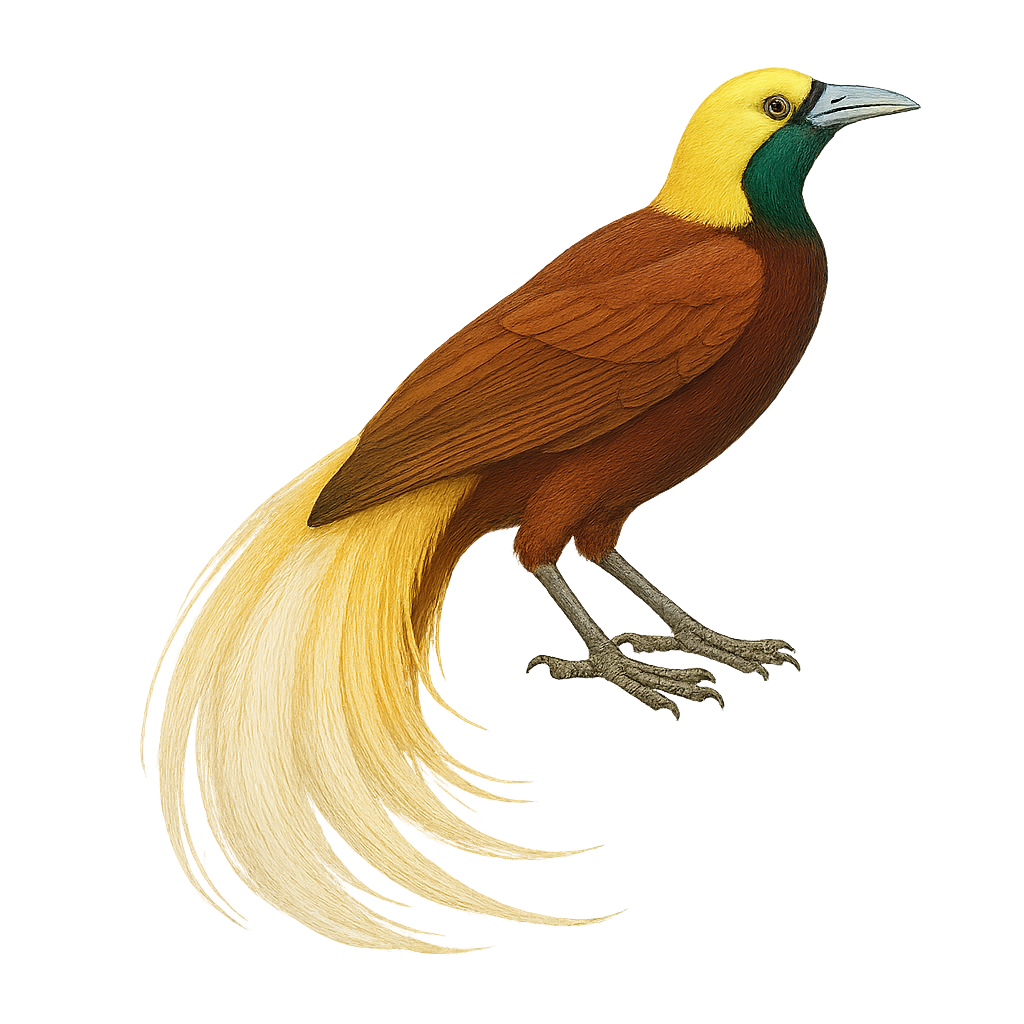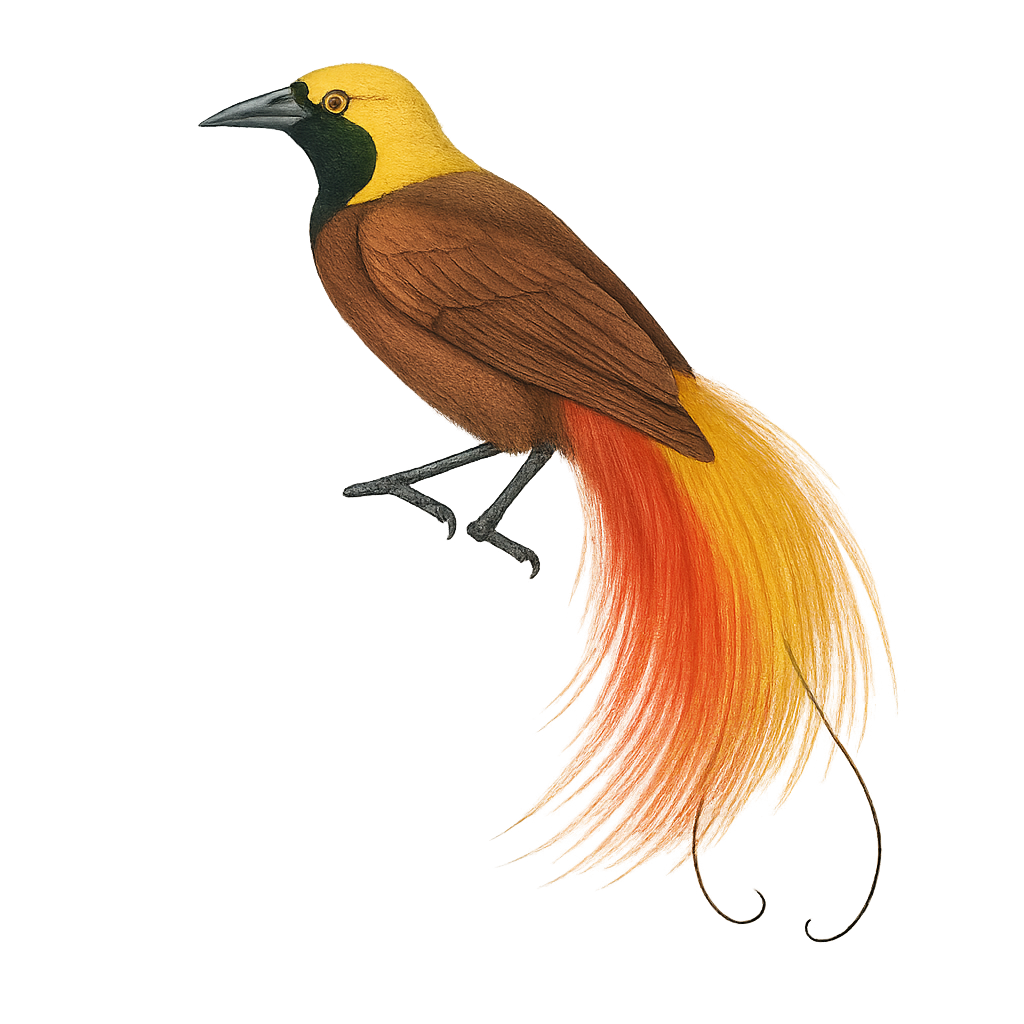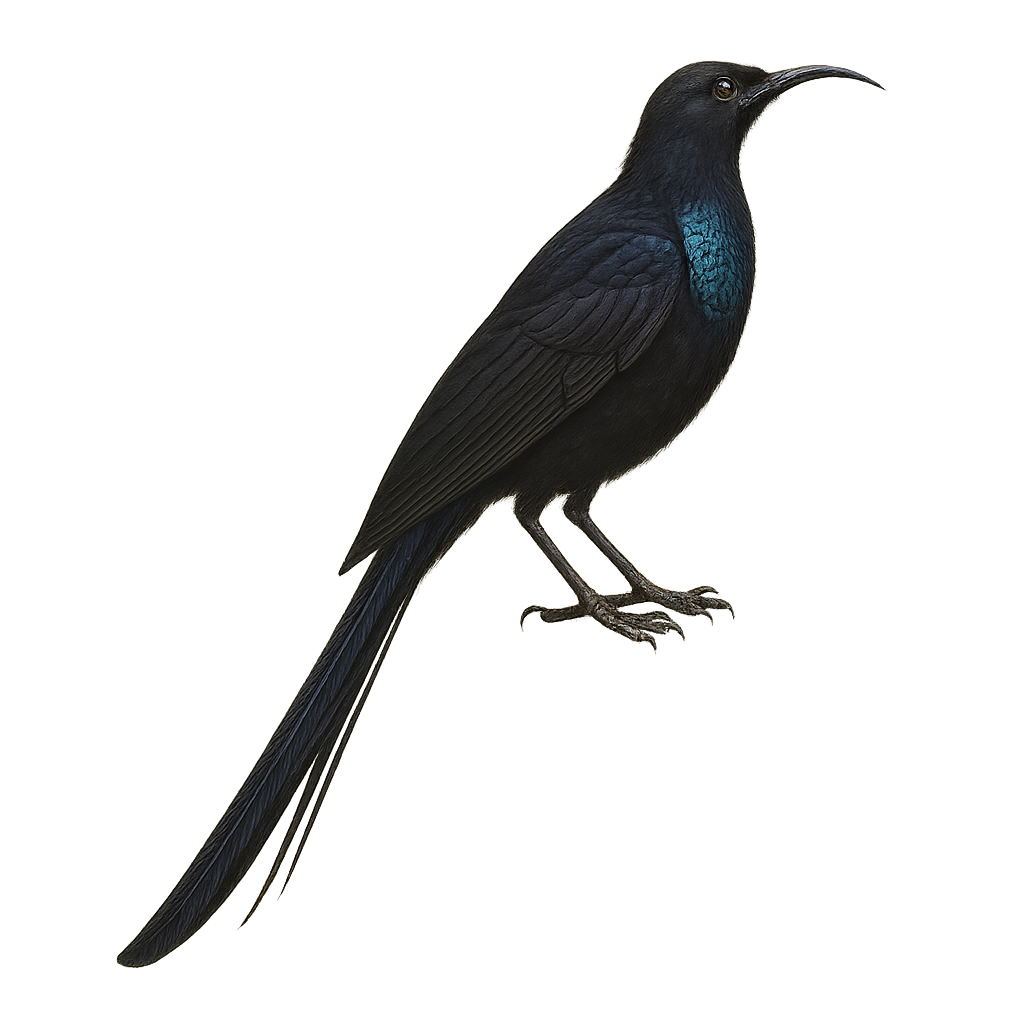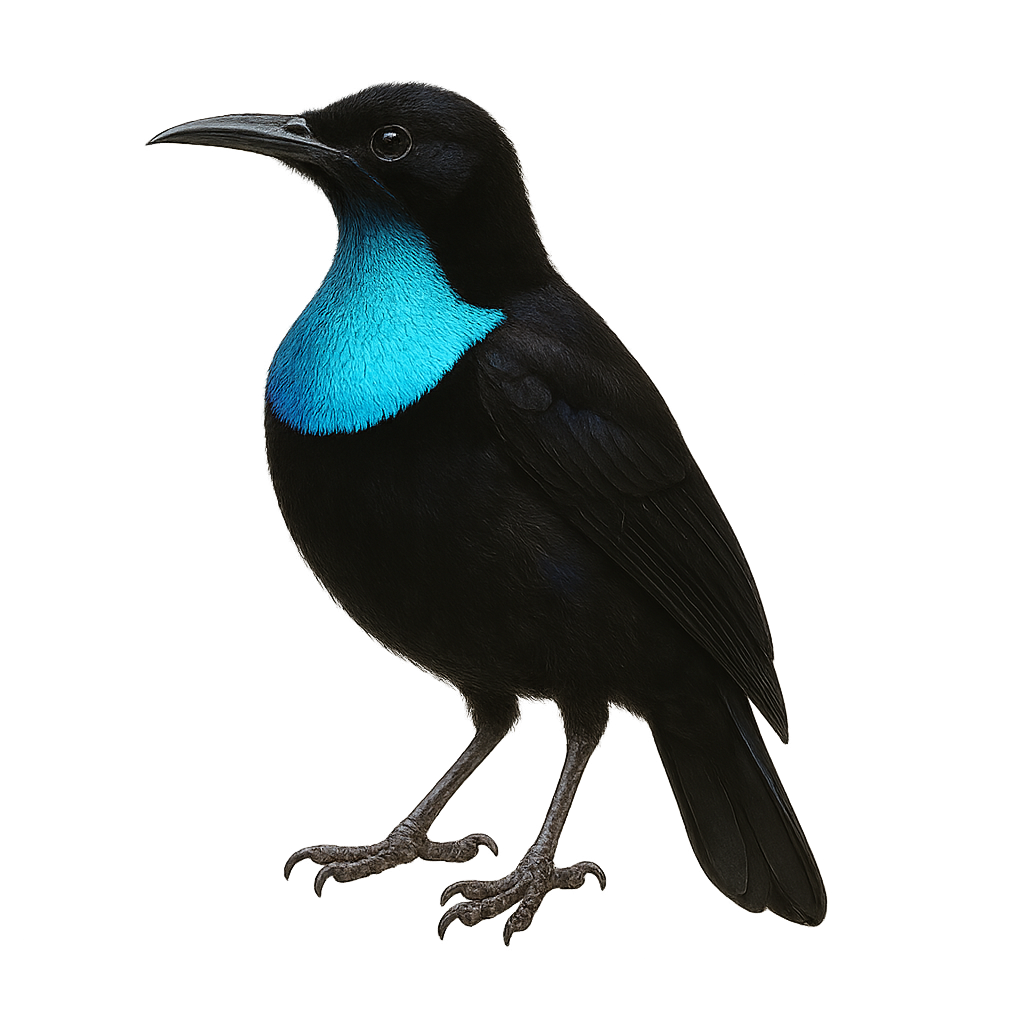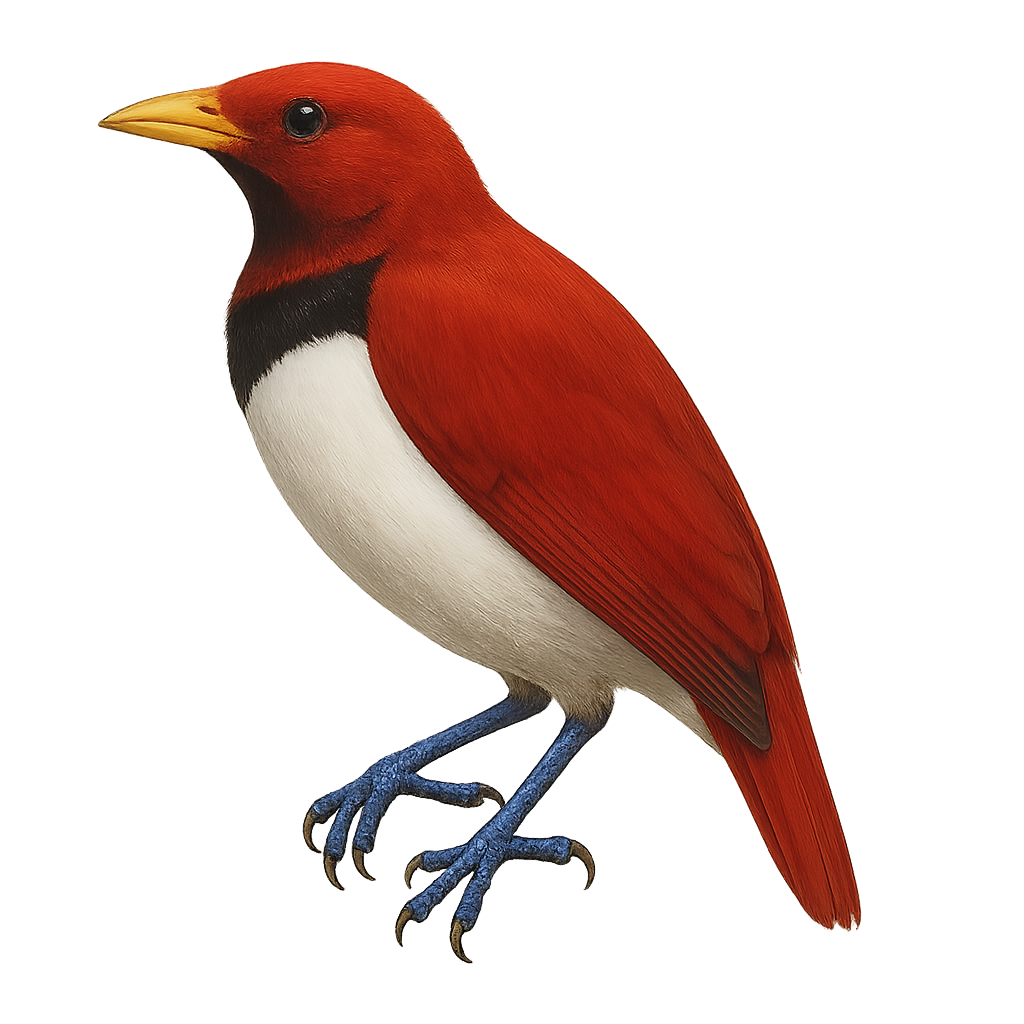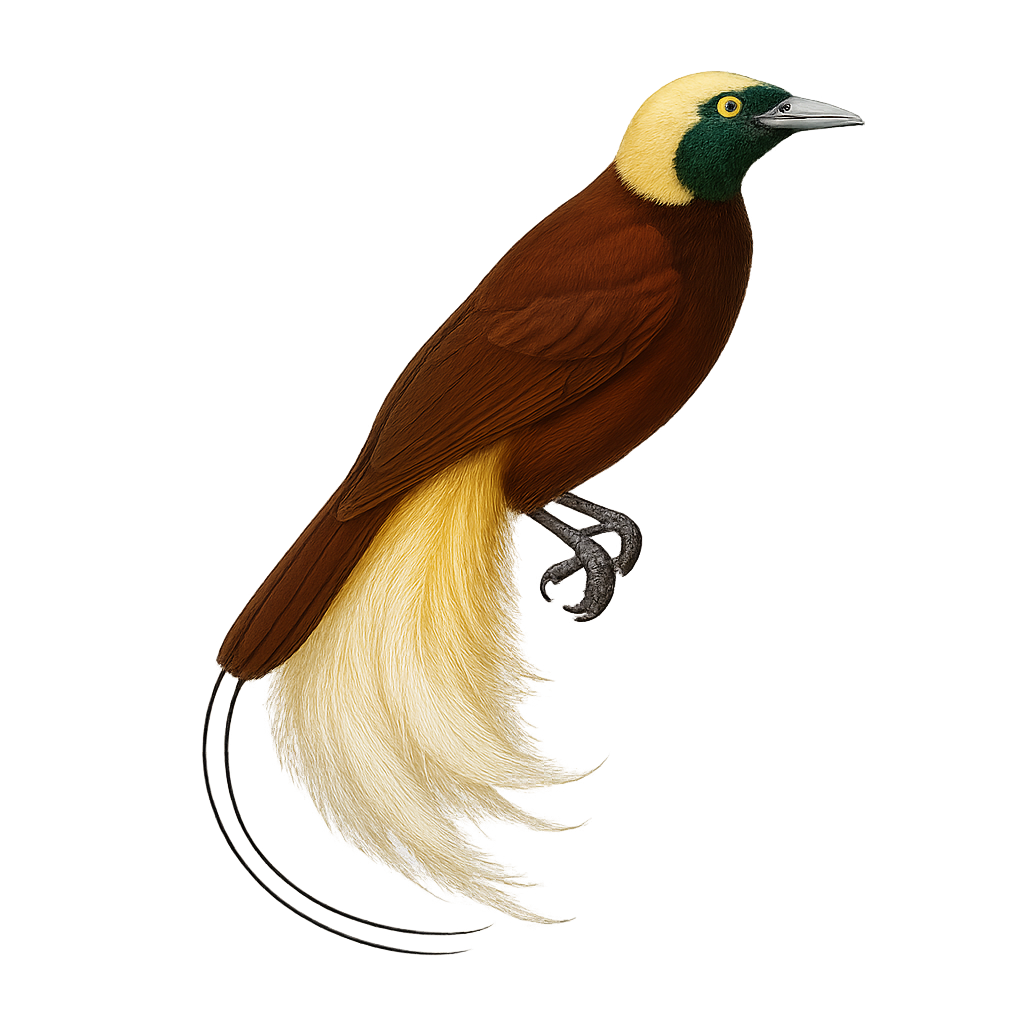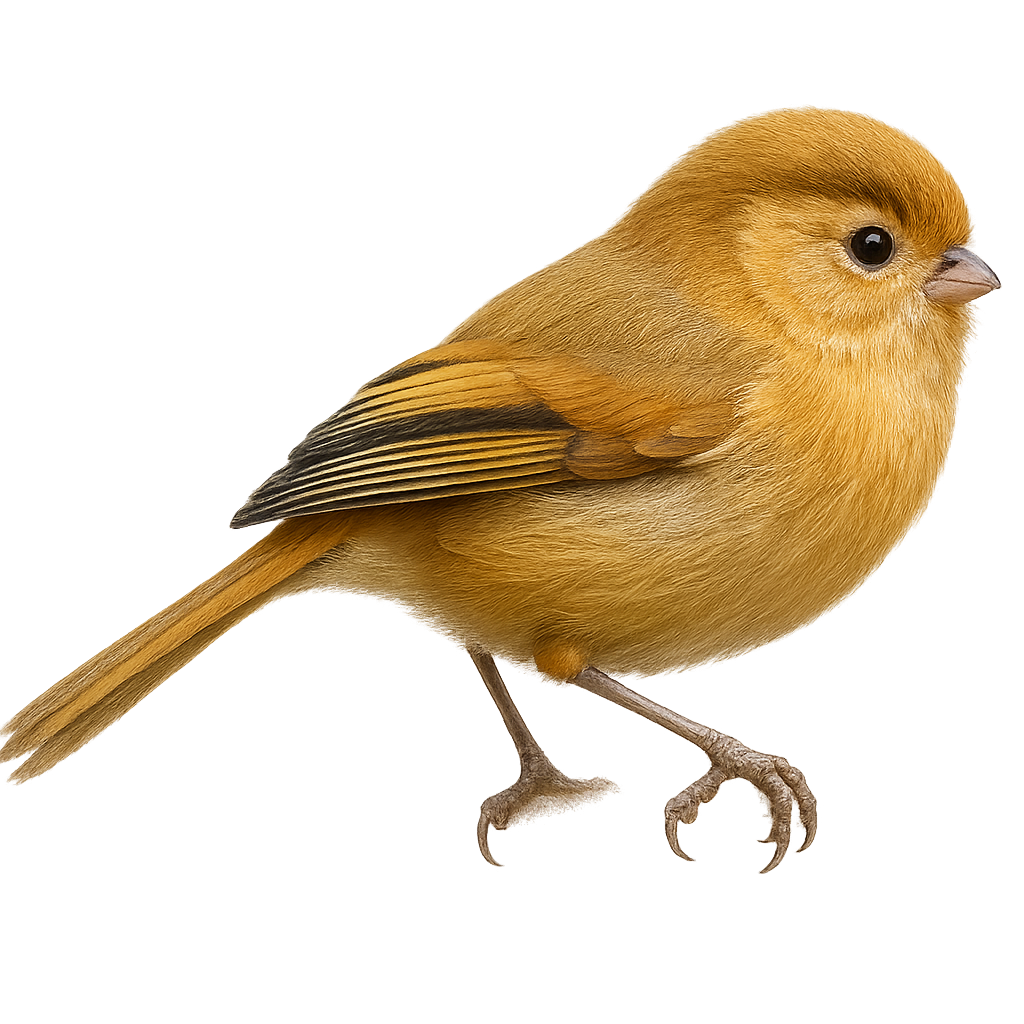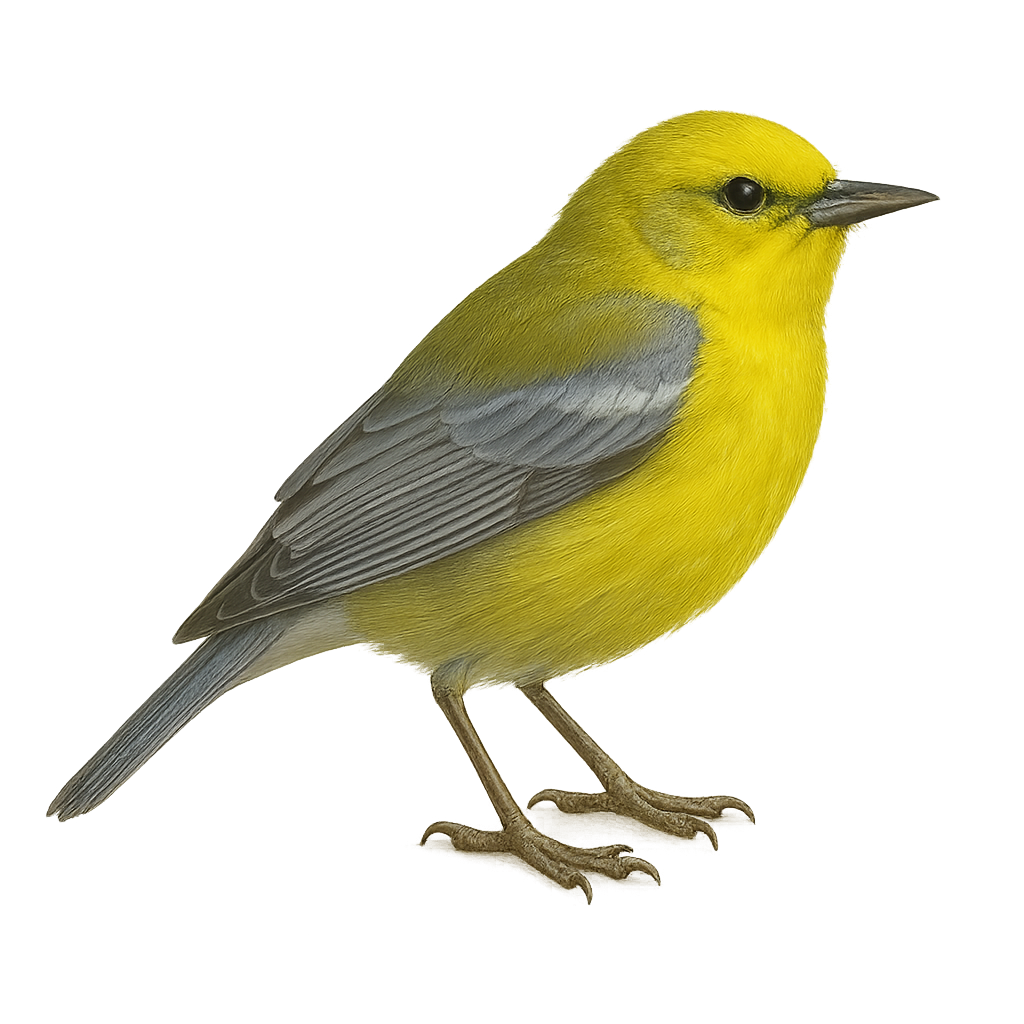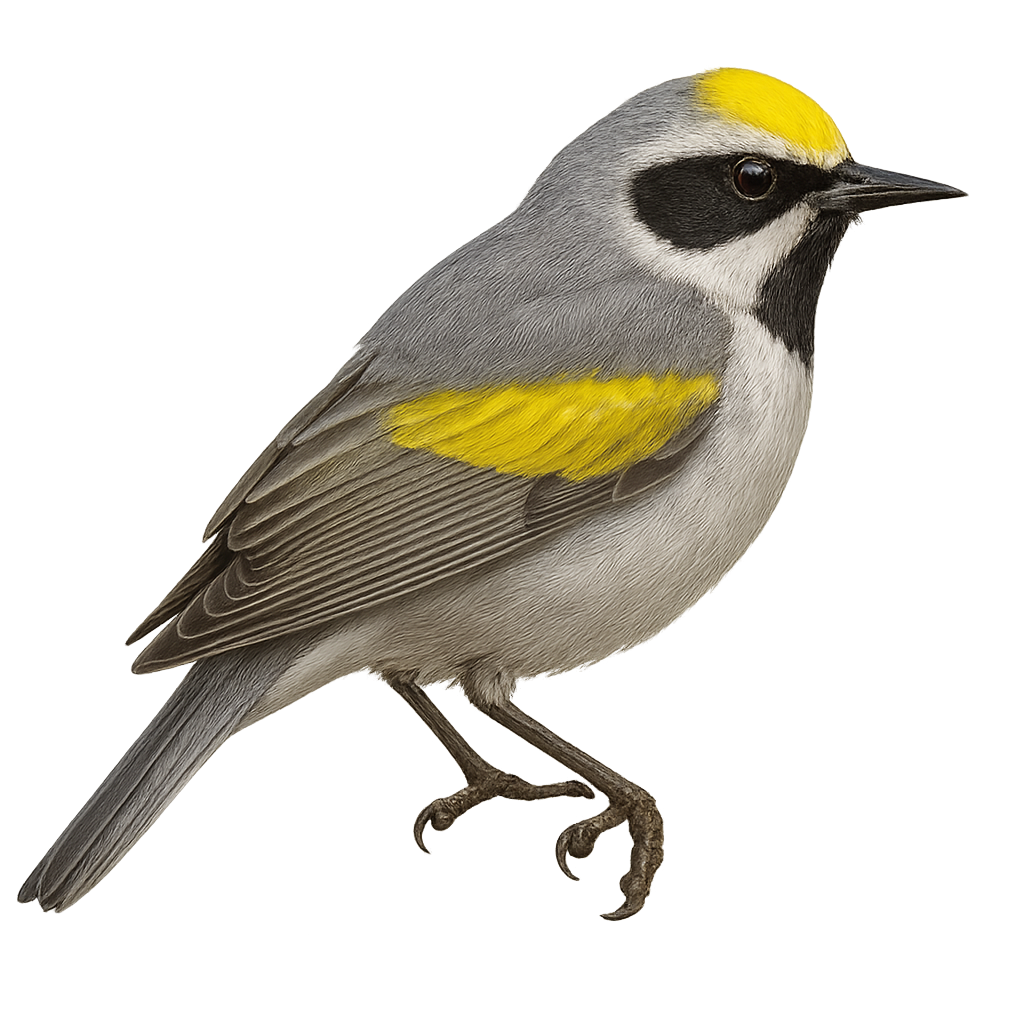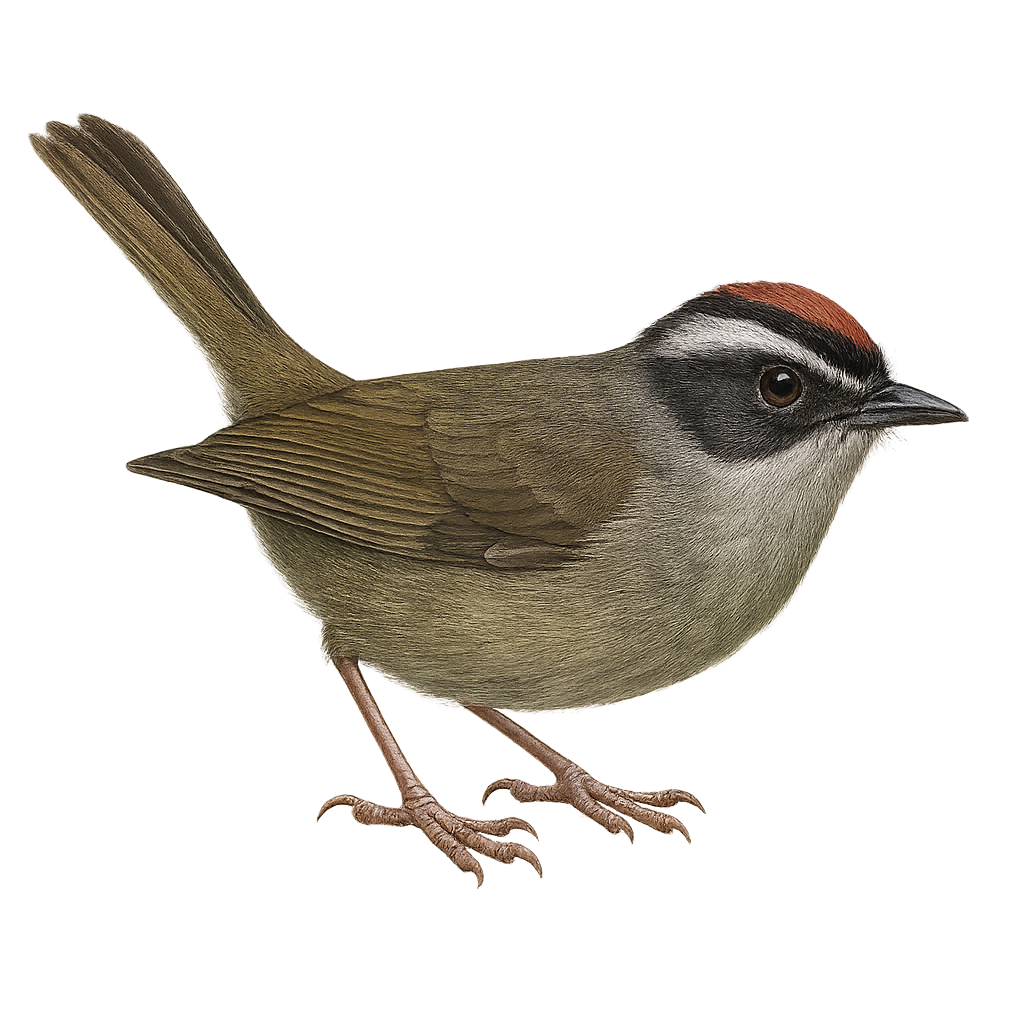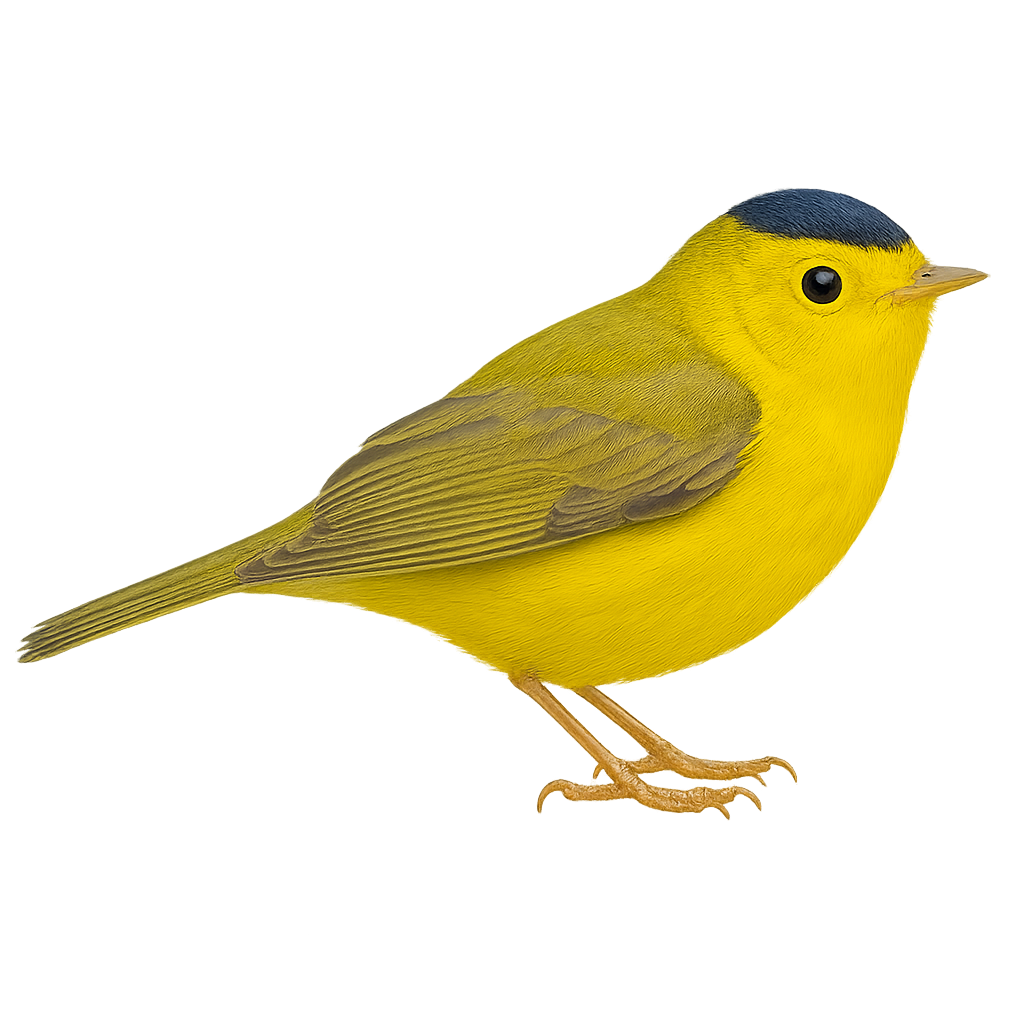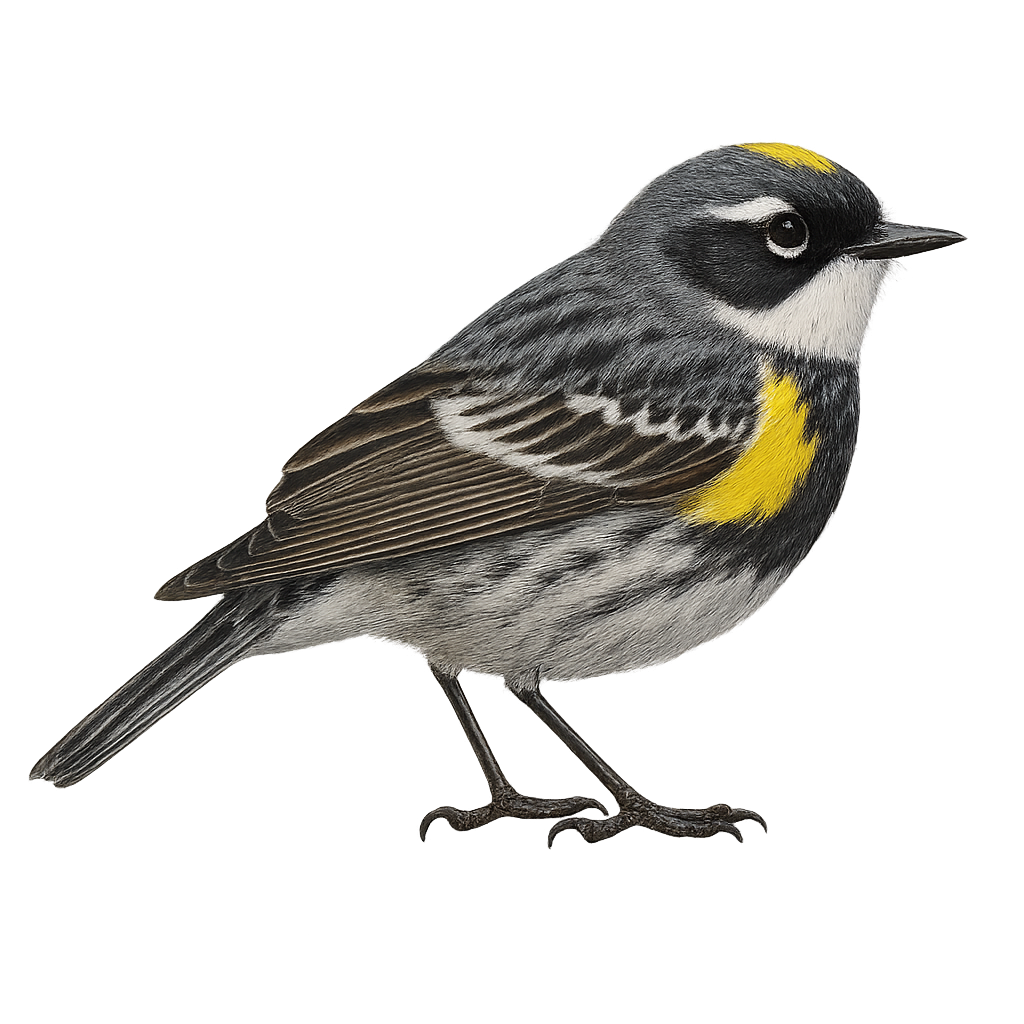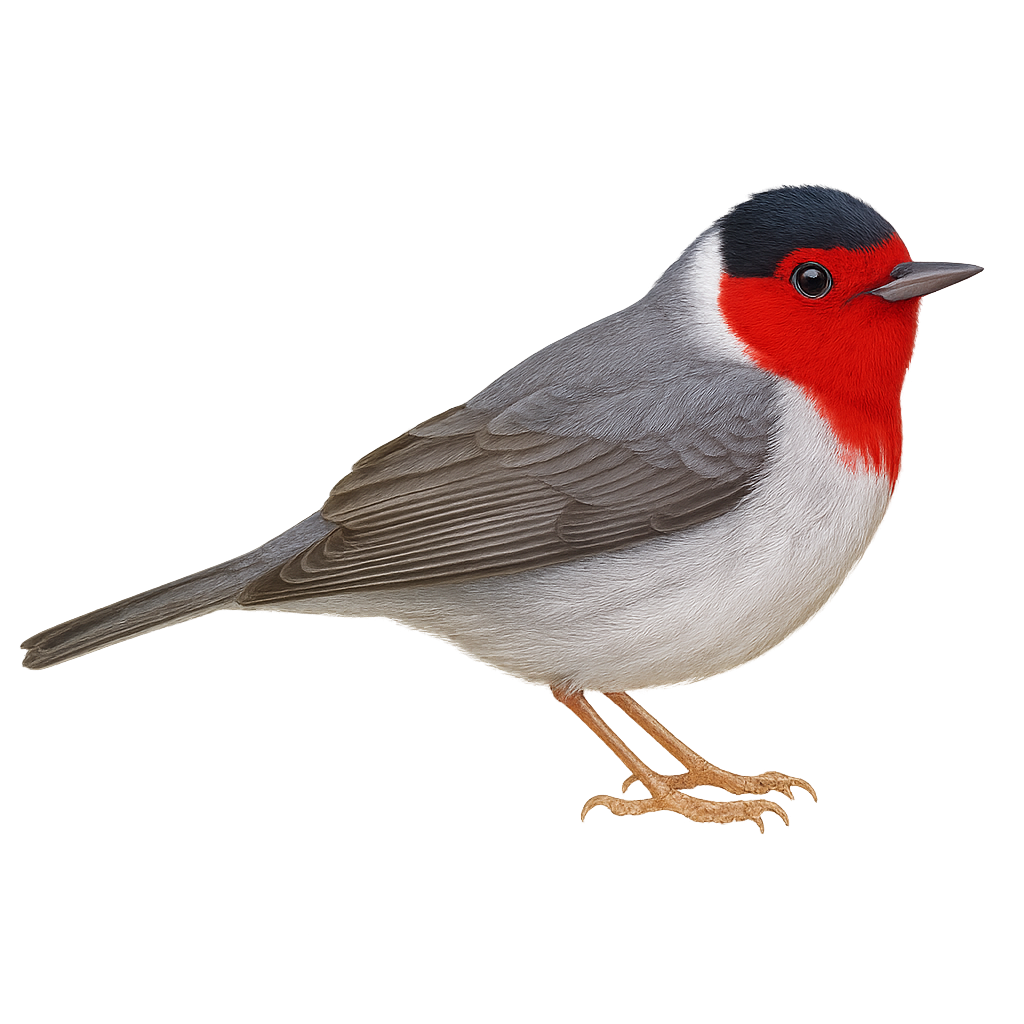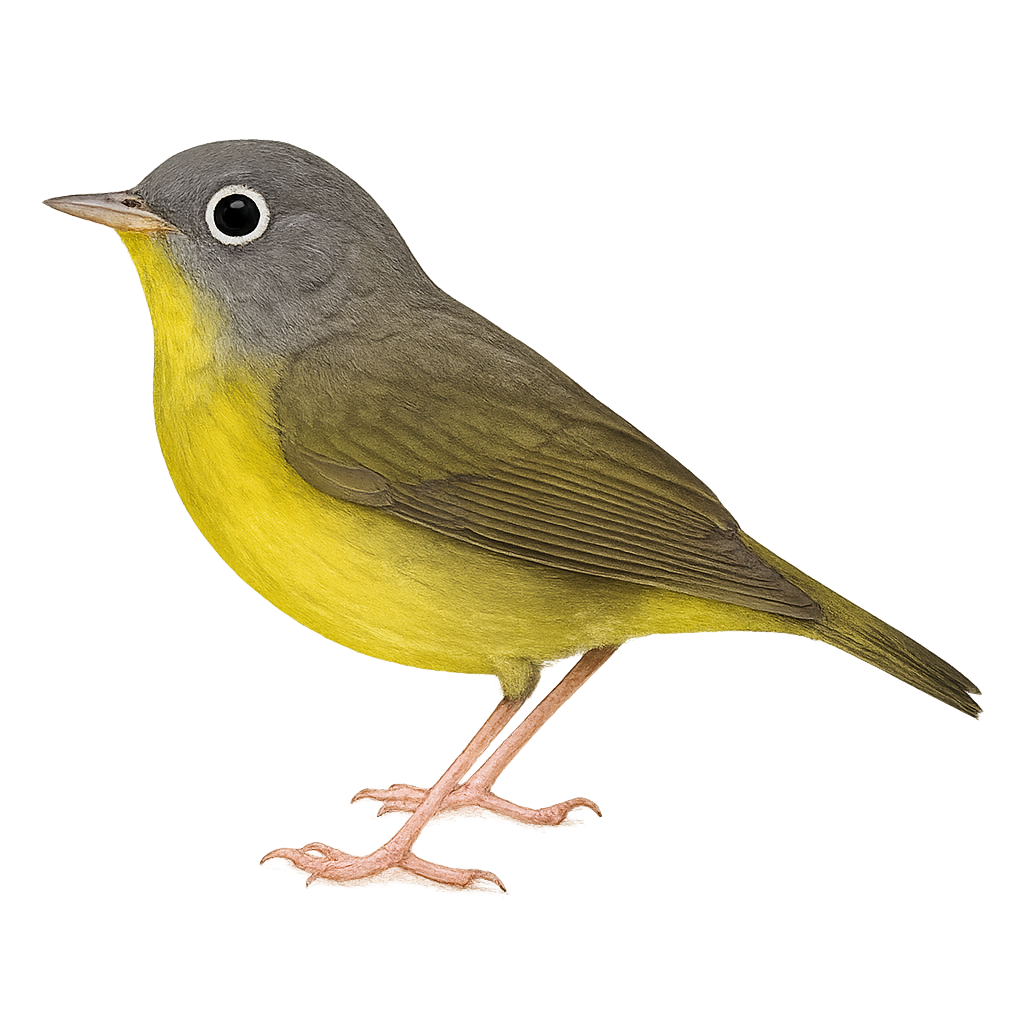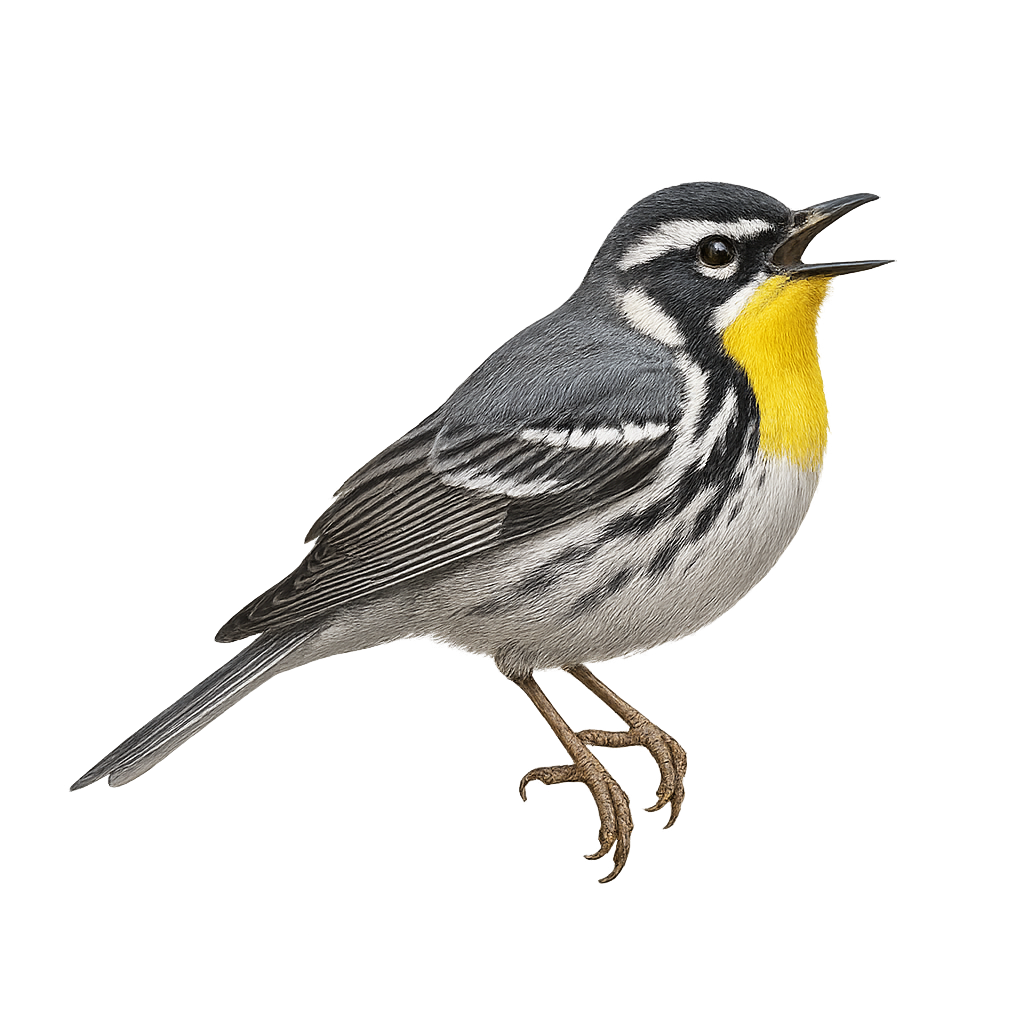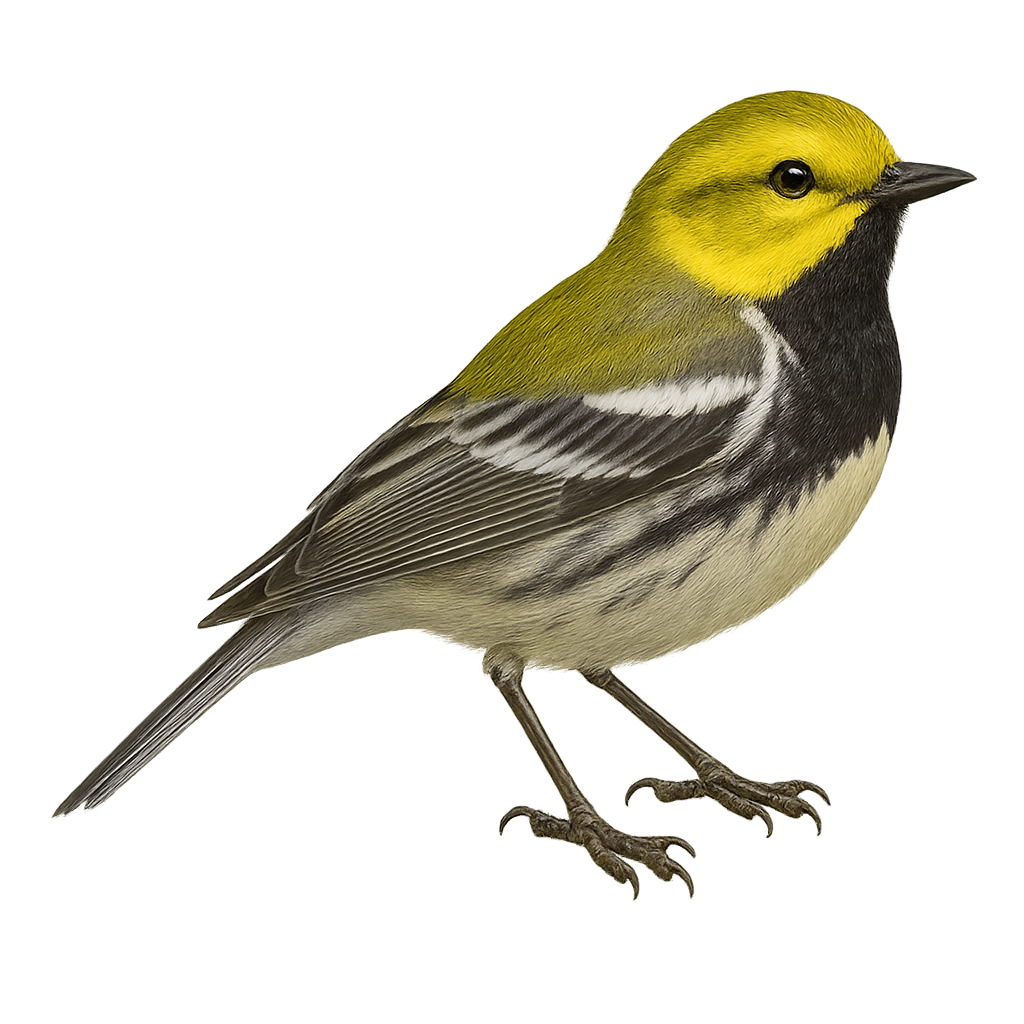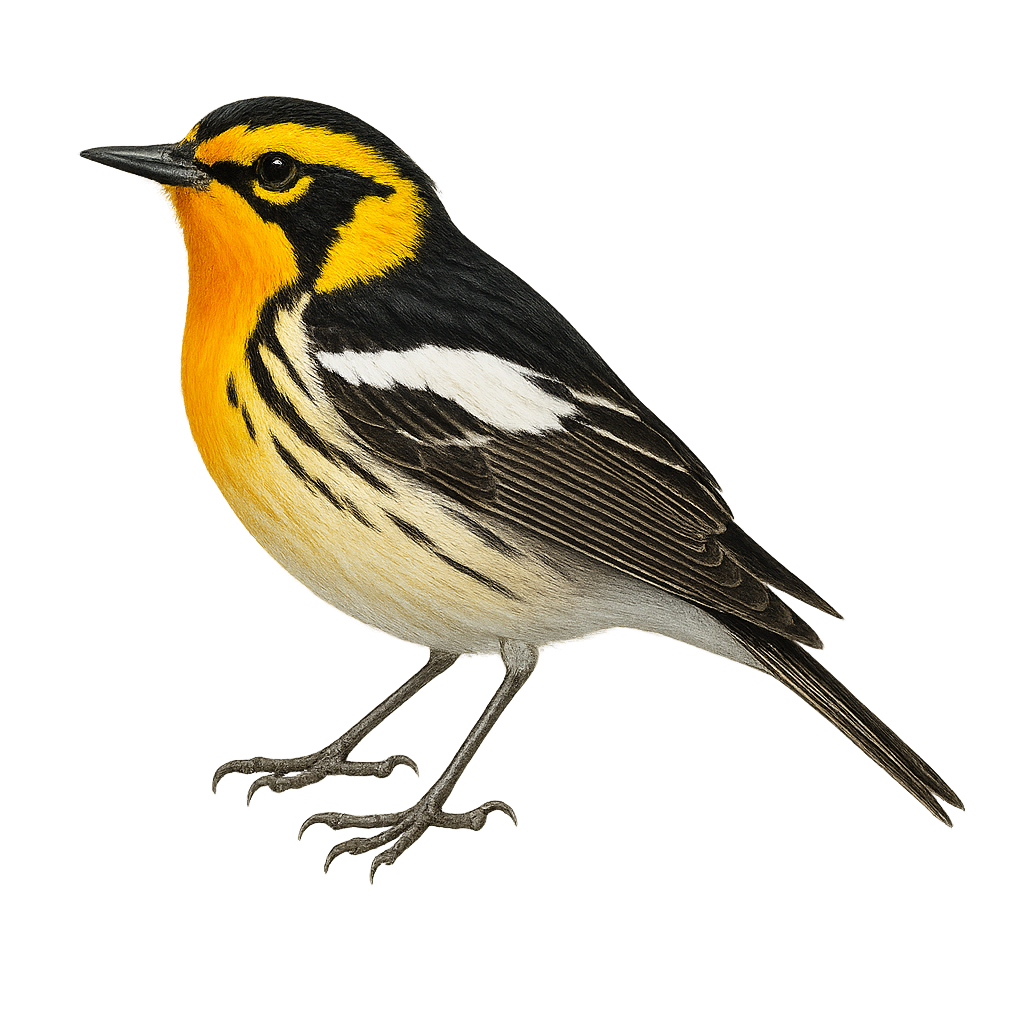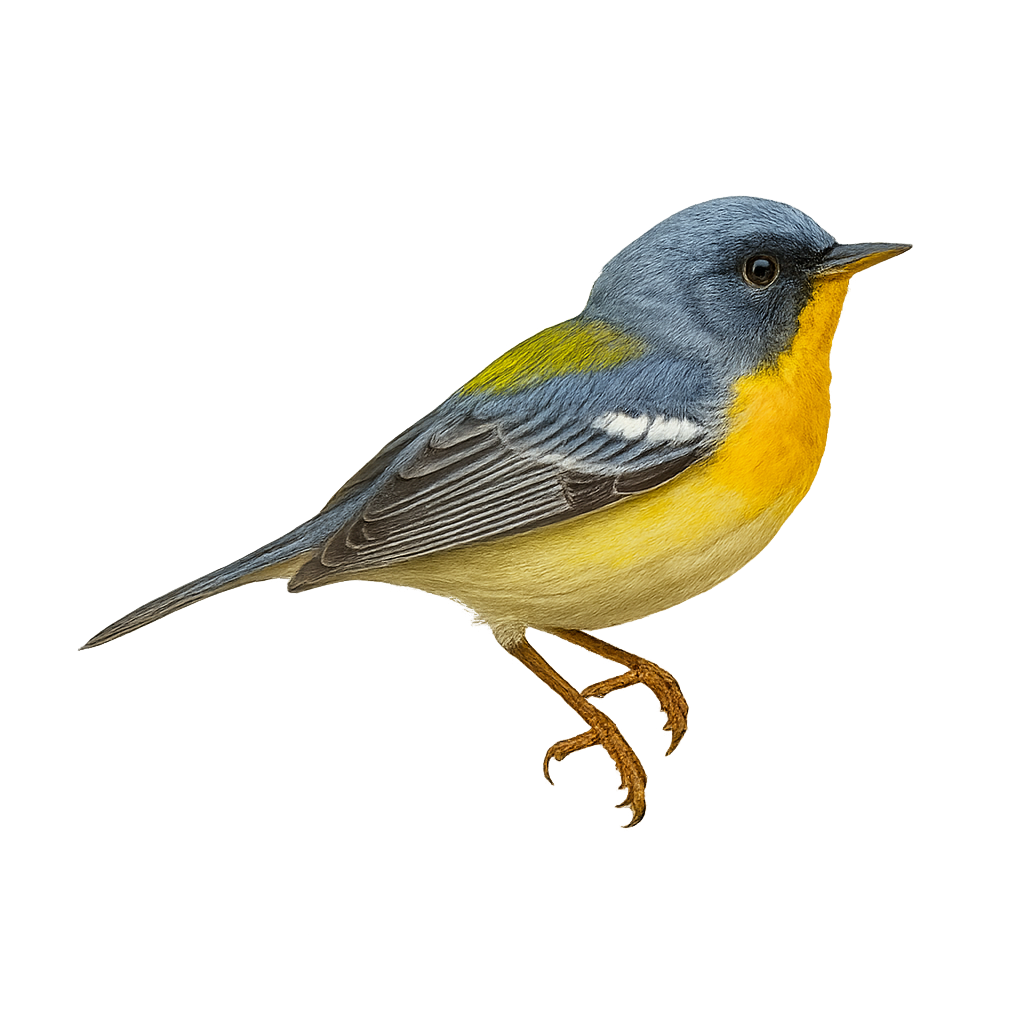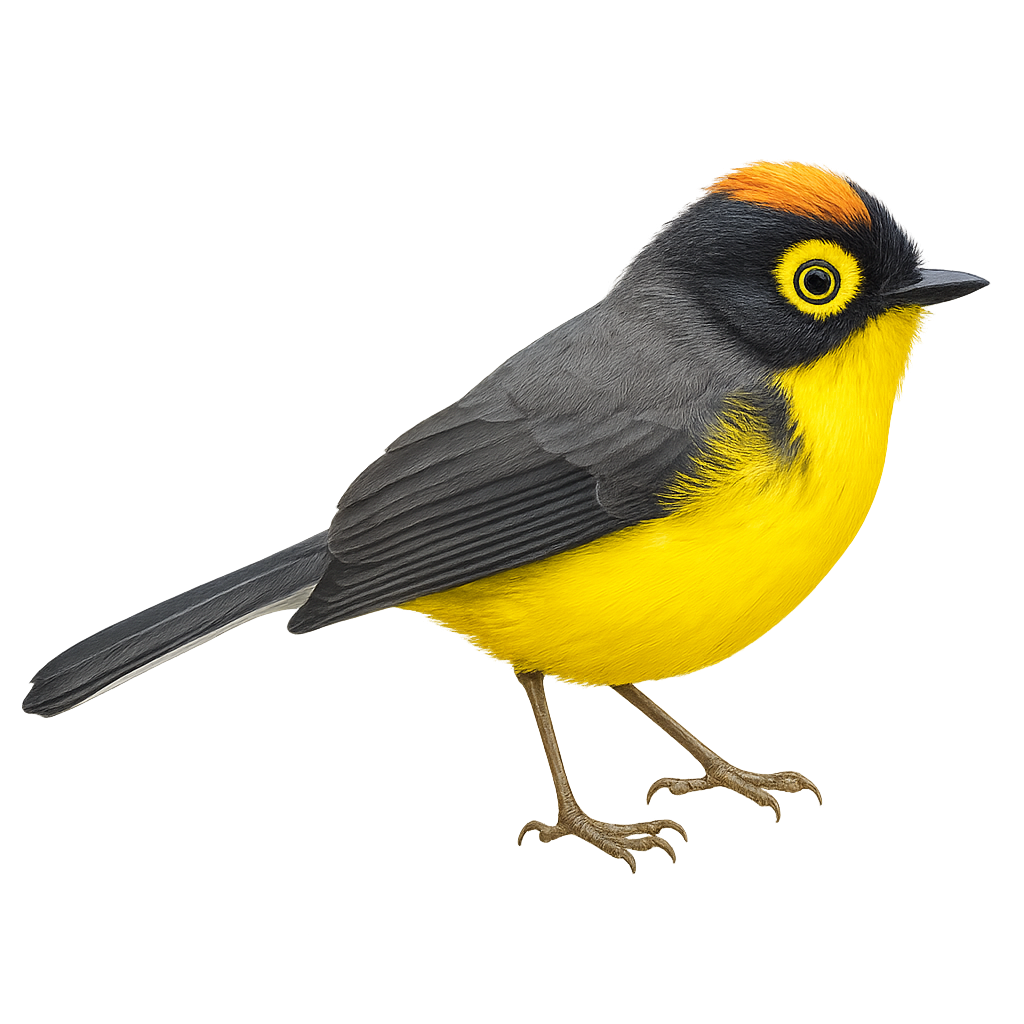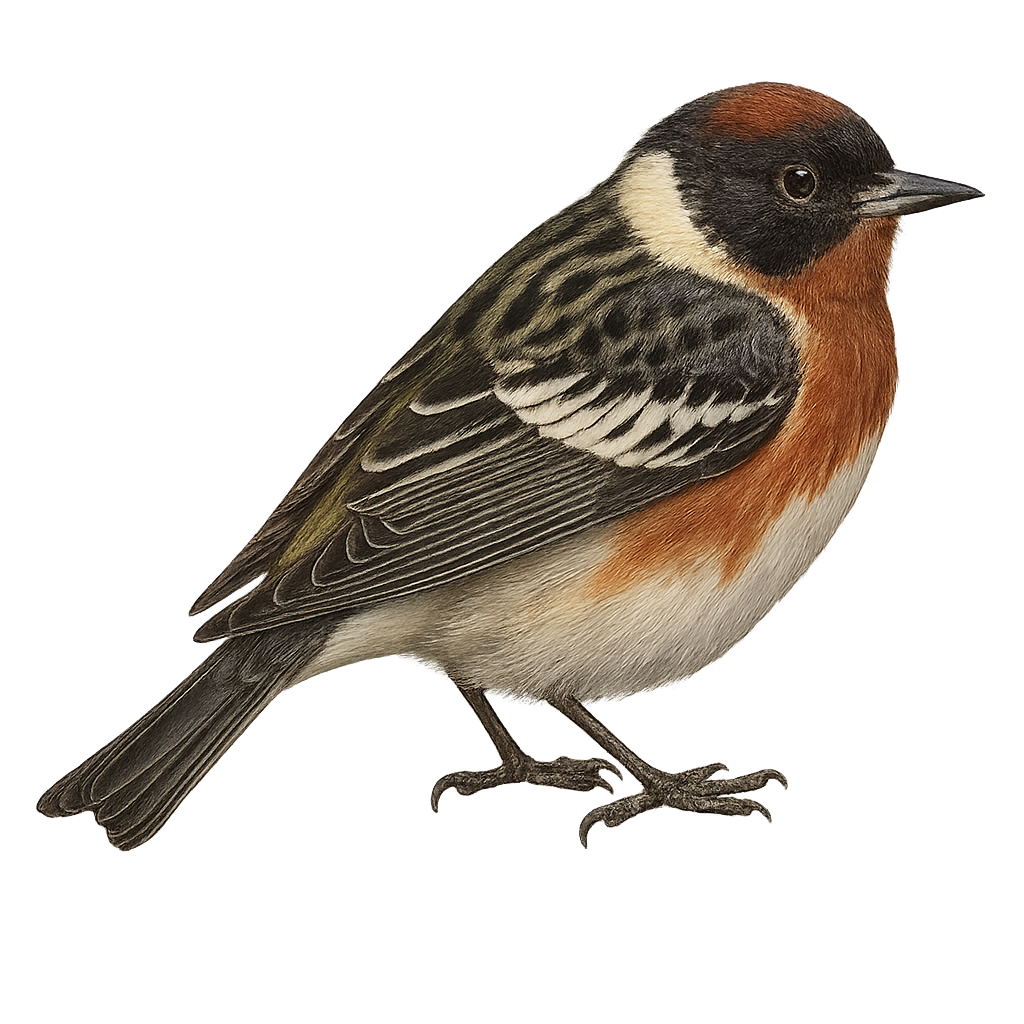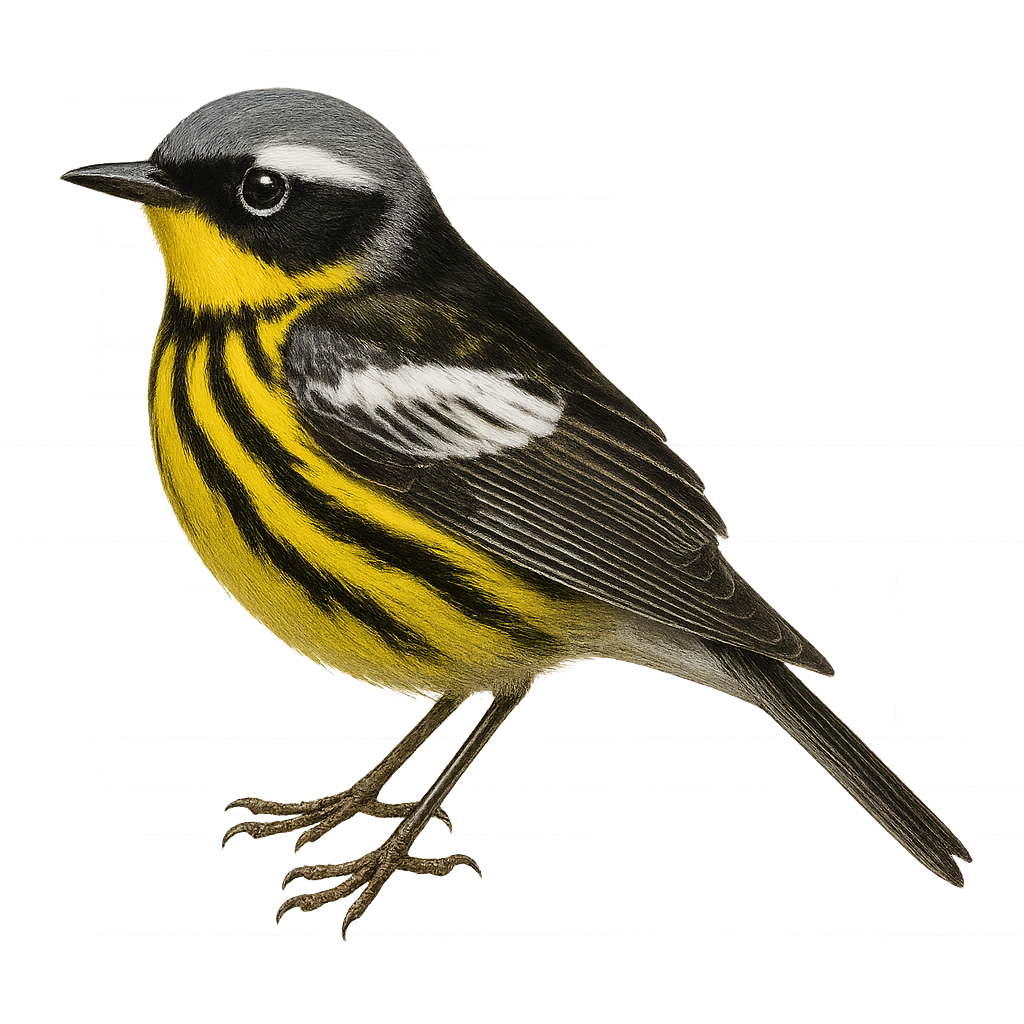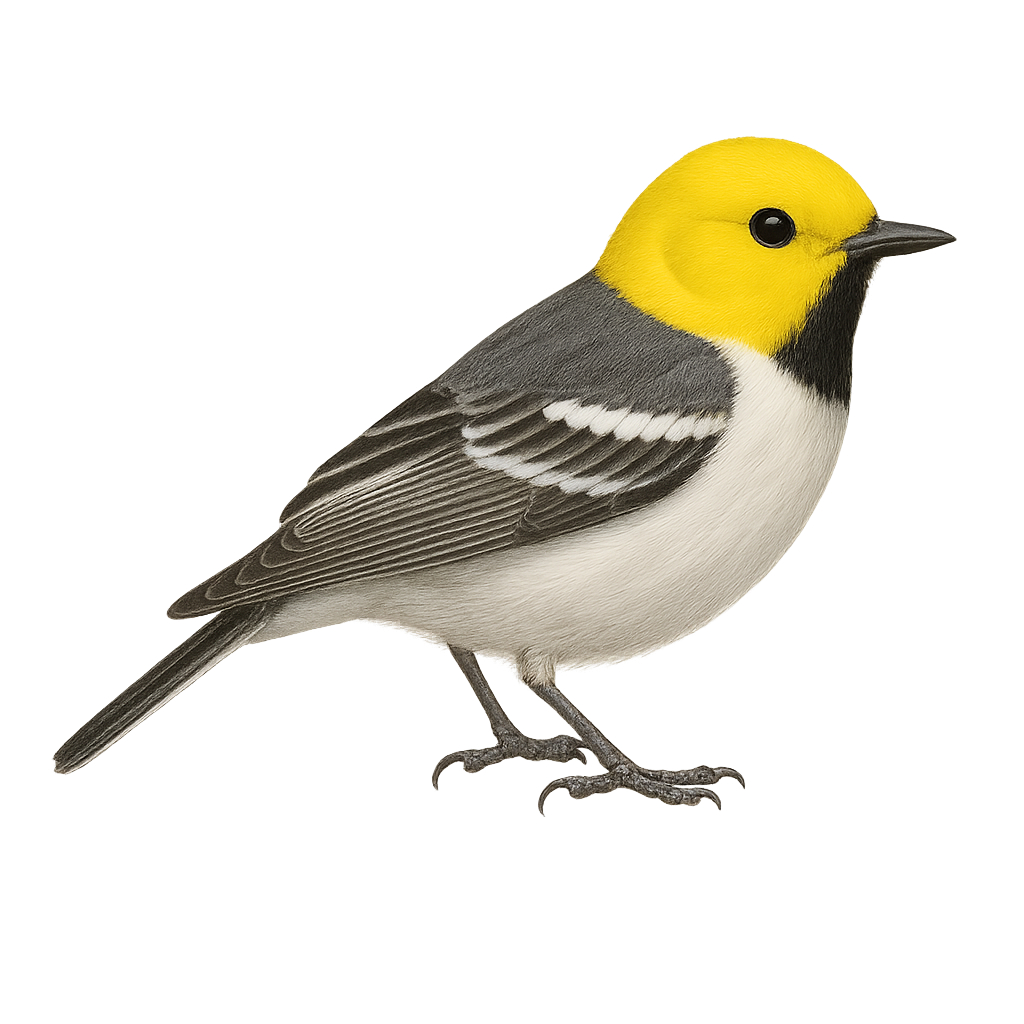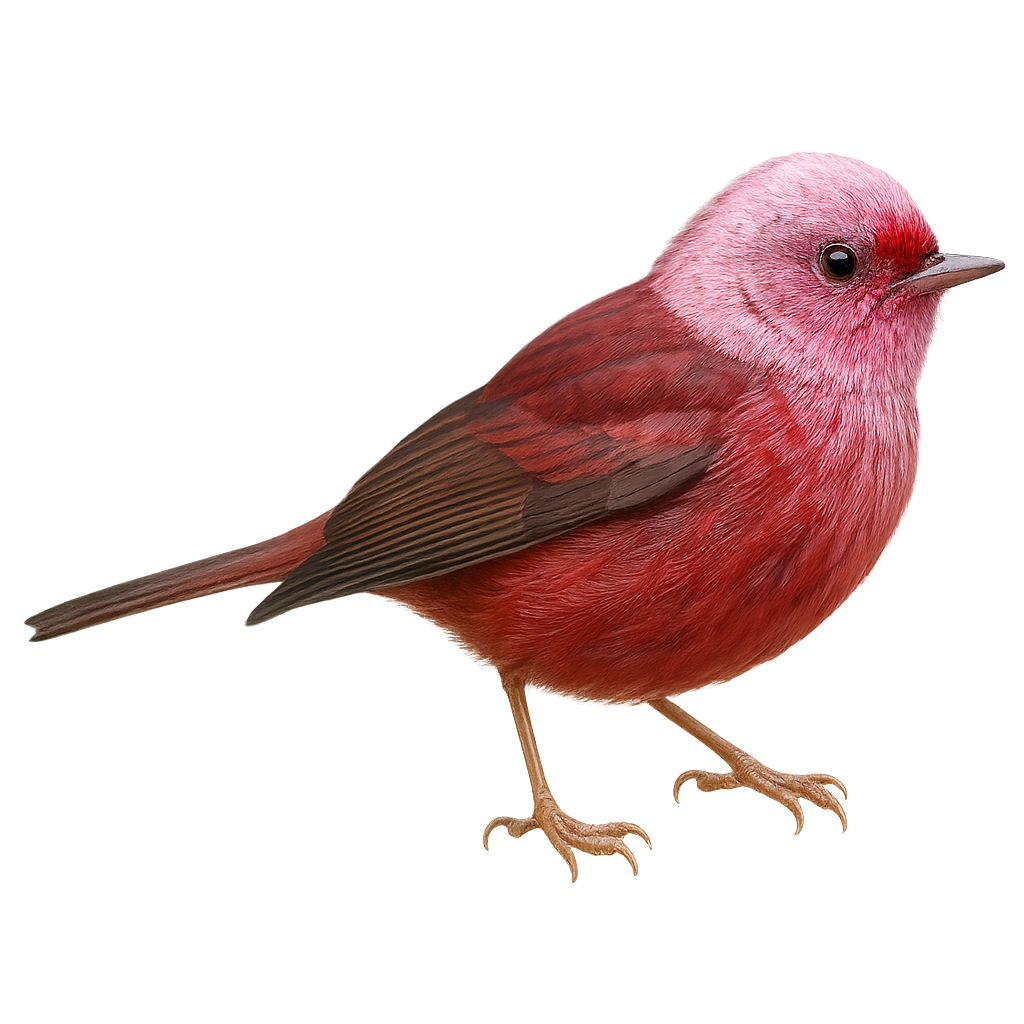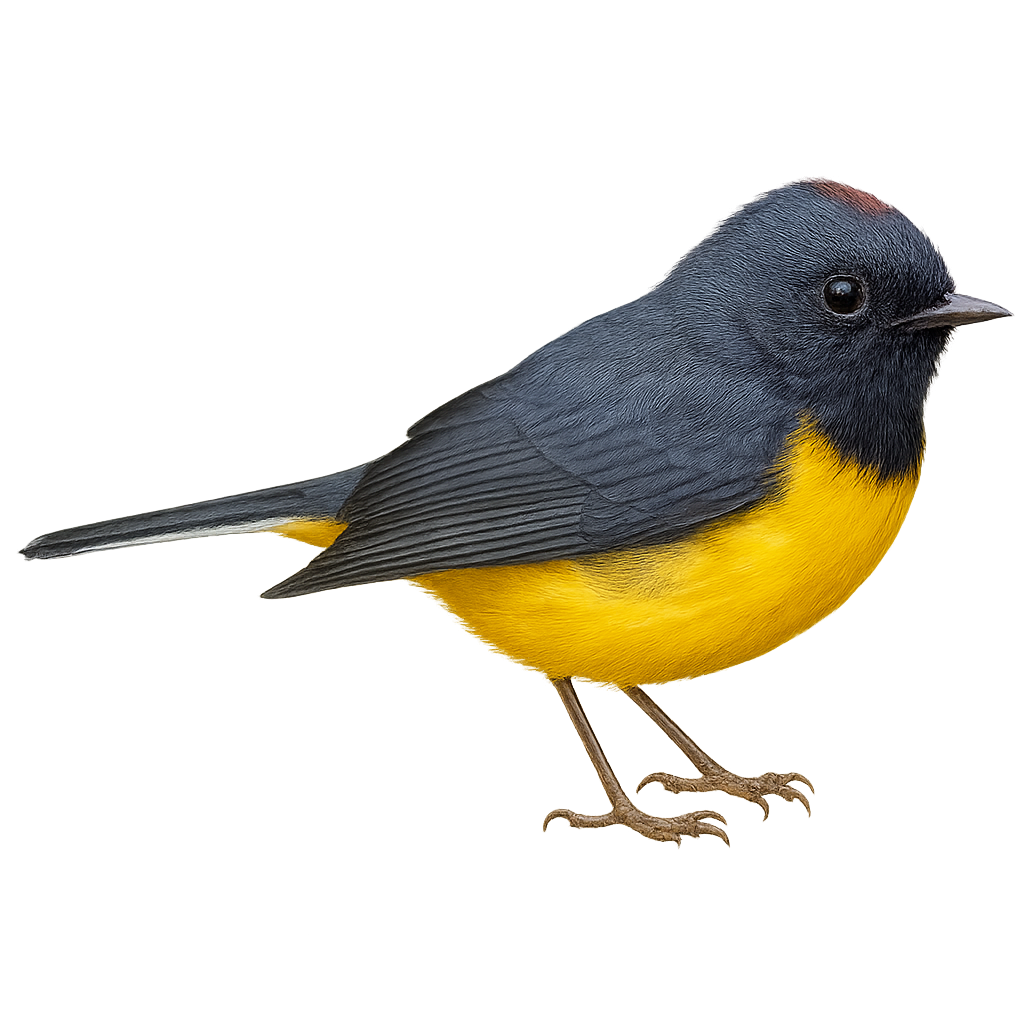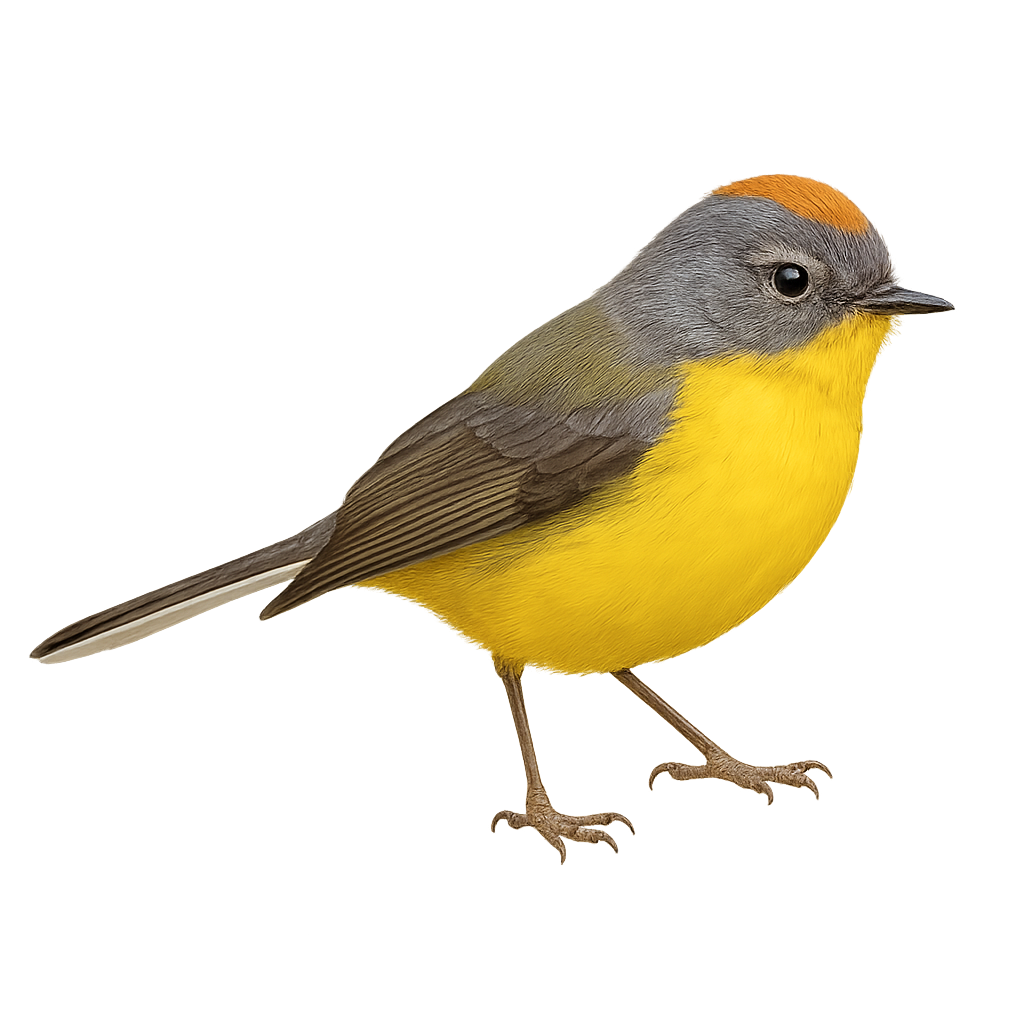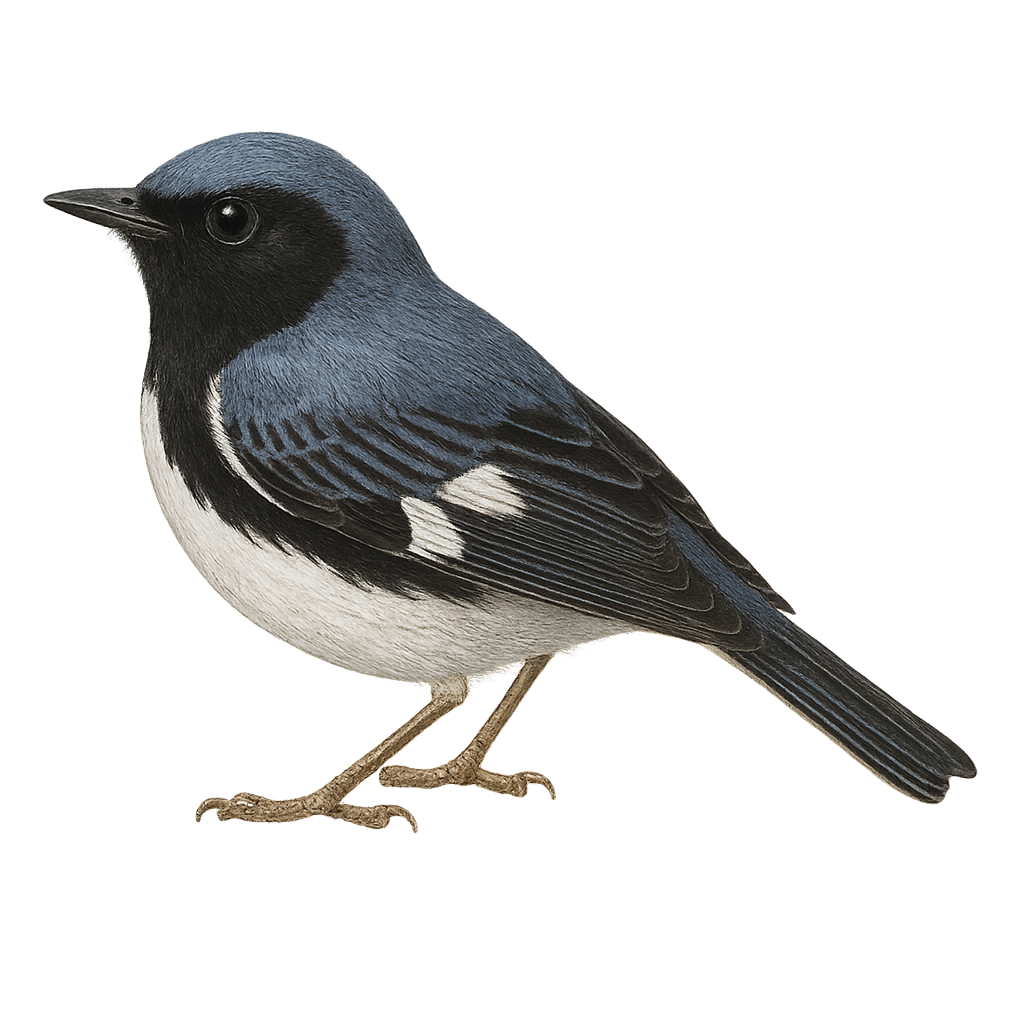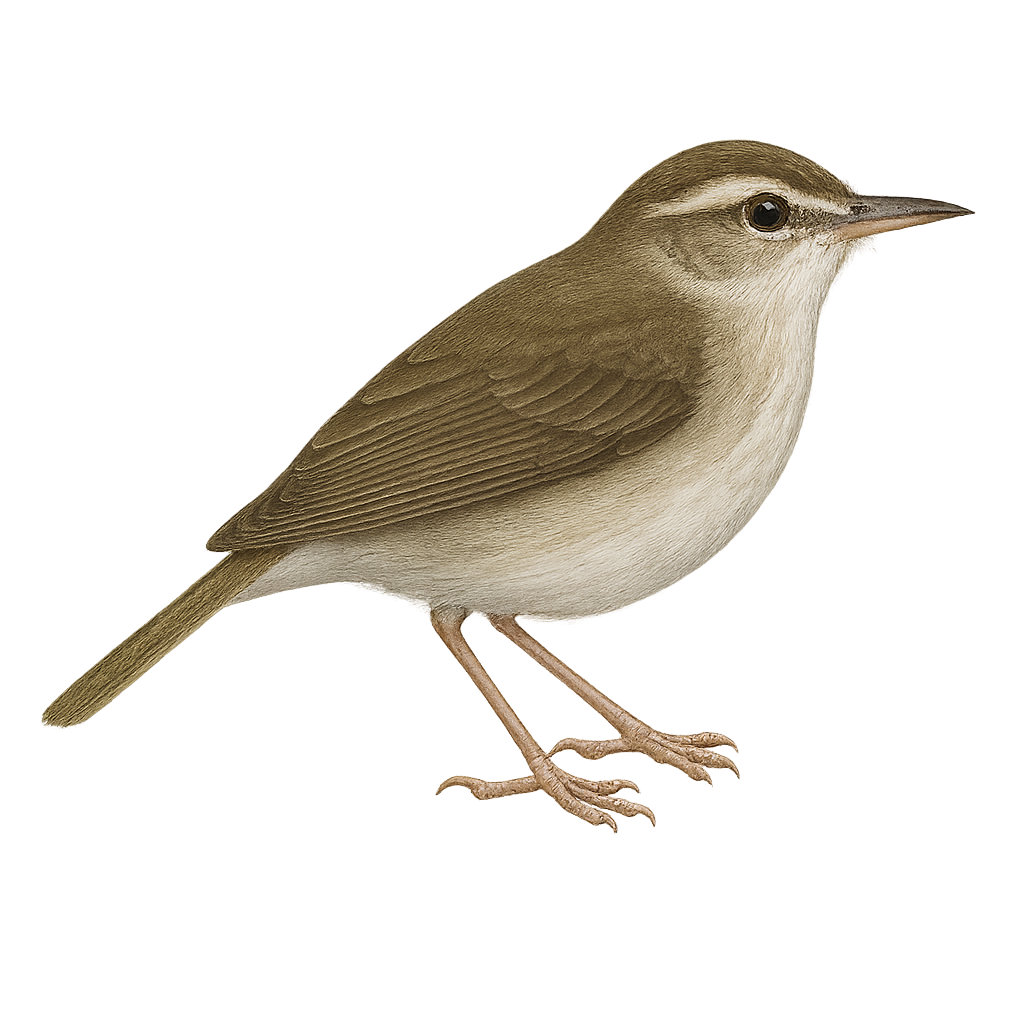The Goldie's Bird-of-paradise, or Paradisaea decora, is a bird species from the Paradisaeidae family, endemic to Fergusson and Normanby islands in Papua New Guinea. This magnificent bird is renowned for its dazzling plumage and spectacular courtship displays. Males boast golden-yellow and emerald-green feathers, with ornamental plumes that unfurl during their courtship dances. Females, more subdued, have olive-brown plumage. The Goldie's Bird-of-paradise primarily inhabits tropical rainforests, feeding on fruits, insects, and small animals. Unfortunately, this species is threatened by deforestation and hunting, leading to its classification as vulnerable by the IUCN.
The Trumpet Manucode, scientifically known as Phonygammus keraudrenii, is a captivating bird from the Paradisaeidae family. It inhabits the tropical rainforests of New Guinea and nearby islands. This bird is notable for its glossy black plumage with metallic sheen and its distinctive trumpet-like call, which gives it its name. The Trumpet Manucode is a medium-sized bird, measuring about 42 cm in length. It primarily feeds on fruits and insects found in the forest canopy. Although its habitat is relatively stable, deforestation poses a potential threat to its population.
The Raggiana Bird-of-paradise, or Paradisaea raggiana, is an iconic bird of the Paradisaeidae family, endemic to Papua New Guinea. It is renowned for its spectacular plumage, especially in males, who display bright red and orange feathers, along with elongated central plumes. These birds are famous for their impressive courtship displays, where males perform complex dances to attract females. They primarily inhabit tropical rainforests, feeding on fruits, insects, and small animals. Their melodious song and complex social behaviors make them a fascinating subject for ornithologists. Although their habitat is threatened by deforestation, they remain relatively common within their range.
The Black Sicklebill, or Epimachus fastuosus, is a bird of the Paradisaeidae family, renowned for its spectacular plumage and elaborate courtship displays. Native to New Guinea, it primarily inhabits montane tropical rainforests. Males are distinguished by their glossy black plumage with metallic sheens and long sickle-shaped tails. They perform complex dances to attract females, who are duller and brown. These birds primarily feed on fruits and insects. Their habitat is threatened by deforestation, leading to a decline in their population. They are currently classified as vulnerable by the IUCN.
The Ptiloris magnificus, or Magnificent riflebird, is a bird of the Paradisaeidae family, renowned for its striking plumage and spectacular courtship displays. Males display glossy black feathers with metallic blue and green sheens, while females are more subdued in brown tones. This bird is endemic to the rainforests of New Guinea and northeastern Australia. It primarily feeds on fruits and insects. Males perform intricate dances to attract females, showcasing their feathers and producing distinctive sounds. Although their habitat is threatened by deforestation, they are not currently critically endangered.
The Republican Paradise-flycatcher is a small bird native to the lowland forests of Sulawesi Island in Indonesia. It measures about 20 cm in length, with a long tail that can reach up to 15 cm, and weighs between 25 and 30 g. What distinguishes the Republican Paradise-flycatcher is its bright coloration, with vivid green, blue, and red feathers and a magnificent crest shaped like a veil. The male, in particular, displays extravagant feathers during courtship displays to attract females. This bird primarily feeds on fruits, seeds, and insects. Although the Republican Paradise-flycatcher is not in immediate danger, deforestation and hunting pose potential threats to its natural habitat.
The King Bird-of-paradise, Cicinnurus regius, is a captivating bird from the Paradisaeidae family, native to the tropical forests of New Guinea and surrounding islands. This small bird, measuring about 16 cm, is renowned for its vibrant plumage and spectacular courtship displays. The male sports bright red plumage with metallic green feathers on the chest and two long spiral-shaped tail feathers. The female, more subdued, has brownish plumage. The King Bird-of-paradise is a solitary bird, except during the breeding season when the male performs intricate dances to attract the female. It primarily feeds on fruits and insects. Although its habitat is threatened by deforestation, it is currently classified as "least concern" by the IUCN.
The Greater Bird-of-paradise, or Paradisaea apoda, is an iconic bird of the tropical forests of New Guinea. Known for its spectacular plumage, the male displays yellow and brown feathers with green and blue hues on the head. These birds are famous for their complex courtship displays, where males showcase their feathers to attract females. They primarily inhabit the forest canopy, feeding on fruits and insects. Their melodious song and social behavior make them fascinating creatures to observe. Although their habitat is threatened by deforestation, they remain relatively common in some areas.
The Albertis's Bird-of-paradise, Drepanornis albertisi, is a captivating bird from the Paradisaeidae family, endemic to New Guinea. This medium-sized bird is recognizable by its striking plumage and long ornamental tail. Males display vibrant colors, with shades of green, blue, and yellow, while females have more subdued plumage. The Albertis's Bird-of-paradise primarily inhabits tropical rainforests and mountainous areas, feeding on fruits, insects, and small animals. Its courtship behavior is particularly spectacular, featuring complex dances and melodious vocalizations to attract females. Although its habitat is threatened by deforestation, the species is currently classified as of least concern by the IUCN.
The Fulvous Parrotbill is a small bird with distinctive plumage, primarily orange with shades of brown and gray. It is recognizable by its short, thick bill, adapted to its diet mainly consisting of seeds and insects. This bird primarily inhabits bamboo forests and dense undergrowth in the mountainous regions of Southeast Asia, notably in China, India, and Myanmar. It is often seen in small flocks, actively moving in search of food. Although its habitat is relatively stable, deforestation and forest fragmentation may pose potential threats to some local populations.
The Blue-winged Warbler, Vermivora cyanoptera, is a small songbird belonging to the Parulidae family. It is easily identified by its bright yellow plumage and distinctive blue wings. This passerine measures about 11 to 13 cm in length with a wingspan of 17 to 20 cm. The male features a bright yellow crown and a black eye stripe, while the female displays duller colors. It inhabits open forests, thickets, and regenerating forest areas. Its song is a distinctive buzzing sound that echoes through its habitat. The Blue-winged Warbler is migratory, wintering in Central America and spending summers in the eastern United States.
The Golden-winged Warbler is a small songbird from the Parulidae family, known for its distinctive patterns and colorful plumage. Males display a golden crown and bright yellow wing patches, contrasting with their black and white face. Females, though less vibrant, have similar but subtler markings. These birds primarily inhabit open forests and shrublands in eastern North America. They are insectivorous, feeding mainly on caterpillars and other small invertebrates. The Golden-winged Warbler is a migratory species, spending its winters in Central and South America. Unfortunately, it is threatened by habitat loss and hybridization with the Blue-winged Warbler.
The Black-cheeked Warbler is a small songbird from the Parulidae family, primarily found in the humid montane forests of Central America, especially in Costa Rica and Panama. Its plumage is marked by a distinctive black cap, contrasting with white cheeks and an olive back. It measures about 12 cm in length and weighs between 9 and 12 grams. This bird is often seen in pairs or small groups, feeding on insects and spiders found in dense foliage. Although its habitat is relatively limited, it is not considered threatened due to the preservation of its forested areas.
The Wilson's Warbler, scientifically known as Cardellina pusilla, is a small songbird with distinctive plumage. It is easily recognizable by its black cap contrasting with its bright yellow body. This species is primarily found in coniferous forests and moist wooded areas, where it feeds on insects and small invertebrates. A migratory bird, it spends its summers in the northern regions of North America and migrates south for the winter. The Wilson's Warbler is known for its melodious song and agile movements among branches. Although its habitat is threatened by deforestation, it remains relatively common and is often observed by birdwatching enthusiasts.
The Yellow-rumped Warbler, Setophaga coronata, is a small songbird belonging to the Parulidae family. Easily identifiable by its bright yellow rump, this feature gives the bird its name. Males display a striking blue-gray plumage with black markings and white flanks, while females and juveniles are duller. Widely distributed across North America, this migratory species breeds in the boreal forests of Canada and winters in the temperate regions of the United States and Mexico. It inhabits various environments, including coniferous forests, mixed woodlands, and shrubby areas. Primarily insectivorous, it feeds on small insects and spiders, but also consumes berries, especially in winter.
The Red-faced Warbler, or Cardellina rubrifrons, is a small, brightly colored songbird primarily found in the coniferous forests of the southwestern United States and Mexico. This passerine is notable for its vivid red face, contrasting with its gray back and white belly. It is often seen foraging for insects in dense foliage, moving with agility and speed. Although its song is subtle, it is recognizable by its melodic trills. The Red-faced Warbler is a migratory bird, spending its winters in the warmer regions of Mexico. Its population is stable, though deforestation poses a potential threat to its natural habitat.
The Connecticut Warbler, or Oporornis agilis, is a migratory bird belonging to the Parulidae family. It is characterized by its subtle plumage, with an olive back and bright yellow belly. Its head is gray with a distinctive white eye-ring. This bird primarily inhabits the boreal forests of Canada and the northern United States during the breeding season, migrating to South America for the winter. Often elusive, it prefers dense habitats, making it challenging to spot. The Connecticut Warbler feeds mainly on insects and larvae, foraging in leaf litter. Its population is stable, but it faces threats from habitat loss due to deforestation.
The Yellow-throated Warbler, Setophaga dominica, is a small songbird in the Parulidae family. It is easily recognizable by its bright yellow throat contrasting with its gray and white plumage. Black stripes on its face and wings add to its distinctive appearance. It primarily inhabits coniferous forests and moist woodlands in the southeastern United States. A migratory bird, it winters in the Caribbean and Central America. Its melodious song and aerial acrobatics make it a favorite among birdwatchers. Although its habitat is sometimes threatened by deforestation, it is currently listed as Least Concern by the IUCN.
The Black-throated Green Warbler is a small songbird belonging to the Parulidae family. It is easily recognizable by its black throat contrasting with its white belly and olive-green back. Males display brighter colors than females, especially during the breeding season. It primarily inhabits coniferous and mixed forests in northeastern North America. As a migratory bird, it winters in the tropical regions of Central America. Its song is distinctive, often described as a "zoo-zee-zoo-zoo-zee". Although its habitat is threatened by deforestation, it is still widespread and considered of least concern by the IUCN.
The Blackburnian Warbler, Setophaga fusca, is a small songbird belonging to the Parulidae family. It is easily identifiable by its bright orange throat, contrasting with its black and white plumage. Males display more vibrant colors than females, especially during the breeding season. This migratory bird primarily nests in the coniferous forests of northeastern North America and migrates to Central and South America for the winter. The Blackburnian Warbler feeds mainly on insects, which it catches in the foliage of trees. It is often seen actively moving through branches in search of food.
The Tropical Parula, or Setophaga pitiayumi, is a small, brightly colored songbird, primarily blue-gray with a bright yellow belly and a white throat. It is found in the tropical and subtropical forests of Central and South America, where it primarily feeds on insects. Often seen actively moving through foliage in search of food, it is easily recognizable by its melodious song. This species is generally solitary or found in small family groups and is known for its adaptability to various habitats, including secondary forests and degraded wooded areas.
The Spectacled Whitestart is a small songbird from the Parulidae family, primarily found in the mountainous forests of Central and South America. It is distinguished by its black head contrasting with its bright yellow body and gray wings. Its melodious song is often heard in dense undergrowth where it primarily feeds on insects. Known for its active behavior, it moves swiftly through foliage. Although generally discreet, it can be observed during its foraging movements. Its presence is an indicator of the health of the forest ecosystems it inhabits.
The Bay-breasted Warbler is a small songbird belonging to the Parulidae family. It is easily recognizable by its chestnut-colored breast, contrasting with its white belly and black and white wings. Males display brighter colors than females, especially during the breeding season. This migratory bird primarily nests in the coniferous forests of Canada and the northern United States, migrating to Central America and northern South America for the winter. Its diet mainly consists of insects, but it can also feed on berries in the fall. The Bay-breasted Warbler is an active and agile bird, often seen foraging in tree branches.
The Magnolia Warbler is a small songbird in the Parulidae family, known for its vibrant plumage and distinctive markings. The male features a black back with white streaks and a bright yellow belly, while the female has duller colors. These migratory birds breed primarily in the coniferous forests of Canada and the northern United States, wintering in Central America. They feed mainly on insects and larvae, capturing them by flitting agilely among branches. Their melodious song is often heard in spring, heralding the breeding season. Although their population is stable, deforestation and habitat loss pose potential threats.
The Hermit Warbler is a small songbird in the Parulidae family, easily identified by its distinctive plumage. It has a black back, wings striped with white, and a black throat contrasting with its white belly. Males display a yellow spot on the cheek, while females have a duller hue. It primarily inhabits coniferous and mixed forests in western North America. A migratory bird, it winters in the southwestern United States and Mexico. Its song is a soft, melodious trill, often heard in spring. It feeds mainly on insects, which it catches by flitting agilely among branches.
The Pink-headed Warbler, or Cardellina versicolor, is a small songbird with distinctive plumage, primarily bright red on the face and throat, contrasting with a gray and white body. It primarily inhabits the coniferous and mixed forests of the southwestern United States and Mexico. This bird is often seen foraging for insects in dense foliage. Although its habitat is relatively stable, the Pink-headed Warbler is sensitive to environmental changes, particularly deforestation. Its breeding season coincides with the abundance of insects, ensuring sufficient food for its young. Ornithologists particularly appreciate its melodious song and liveliness.
The Slate-throated Whitestart, or Myioborus miniatus, is a small, brightly colored songbird primarily found in the mountainous forests of Central and South America. It is distinguished by its vivid red head, gray back, and bright yellow belly. This bird is often seen actively hopping through the underbrush in search of insects. Its behavior is generally tolerant towards humans, making it an ideal subject for amateur birdwatchers. The Slate-throated Whitestart is also known for its dynamic courtship displays, where it fans its tail to impress potential mates. Although not currently threatened, deforestation poses a potential risk to its natural habitat.
The Brown-capped Whitestart, Myioborus brunniceps, is a small songbird in the Parulidae family. It is characterized by its dark brown head contrasting with a gray body and black wings. Its tail feathers are white, which is particularly noticeable in flight. It primarily inhabits mountain forests and wooded areas in South America, especially in Argentina and Bolivia. Its song is melodious and complex, often used to mark its territory. The Brown-capped Whitestart is a diurnal bird, active mainly in the morning and late afternoon. It feeds primarily on insects caught in flight or on leaves.
The Black-throated Blue Warbler is a small songbird from the Parulidae family, easily identified by the male's vibrant blue plumage, contrasting black throat, and white flanks. The female is more subdued, with olive tones and a distinctive white eyebrow. This species primarily inhabits deciduous forests and dense undergrowth in eastern North America. As a migratory bird, it winters in the Caribbean and Central America. Its melodious song and distinctive calls make it a favorite among birdwatchers. The Black-throated Blue Warbler feeds mainly on insects and larvae, which it skillfully catches while flitting among branches.
The Swainson's Warbler, Limnothlypis swainsonii, is a secretive and little-known bird, primarily found in the humid forests of the southeastern United States. It is characterized by its olive-brown plumage, pale eyebrow, and relatively long, slender bill. This bird prefers dense undergrowth and swamps, where it feeds mainly on insects and spiders. Although its song is melodious, it is often difficult to spot due to its elusive behavior. The Swainson's Warbler is a partial migrant, moving south for the winter. Its population is stable, but it remains vulnerable to habitat loss due to deforestation and wetland drainage.


